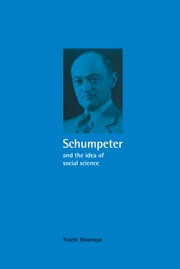Book contents
- Frontmatter
- Contents
- List of figures
- Preface
- 1 Introduction
- 2 Schumpeter and his surroundings: an overview
- 3 The scope and methods of Schumpeter's research program
- 4 The sociology of science and Schumpeter's ideology
- 5 The economic methodology of instrumentalism
- 6 Static economics as an exact science
- 7 The theory of economic development as a midpoint
- 8 A methodology of economic sociology
- 9 Economic sociology as an evolutionary science
- 10 The historical world of economics
- 11 Value judgments and political economy
- 12 Conclusion: Schumpeterian synthesis
- Notes
- List of references
- Index
2 - Schumpeter and his surroundings: an overview
Published online by Cambridge University Press: 18 September 2009
- Frontmatter
- Contents
- List of figures
- Preface
- 1 Introduction
- 2 Schumpeter and his surroundings: an overview
- 3 The scope and methods of Schumpeter's research program
- 4 The sociology of science and Schumpeter's ideology
- 5 The economic methodology of instrumentalism
- 6 Static economics as an exact science
- 7 The theory of economic development as a midpoint
- 8 A methodology of economic sociology
- 9 Economic sociology as an evolutionary science
- 10 The historical world of economics
- 11 Value judgments and political economy
- 12 Conclusion: Schumpeterian synthesis
- Notes
- List of references
- Index
Summary
In the latter half of the nineteenth century the Habsburg monarchy with its glorious history of six hundred years enjoyed the last epoch of brilliance as the Austro-Hungarian Empire. Vienna, the capital, was the cultural center of Europe; there from the 1880s to the 1910s, many great thinkers, artists, and scientists prevailed in the fields of literature, painting, music, philosophy, natural science, psychology, and social science. After triggering World War I, however, the Empire was defeated and collapsed.
The crucial moment
Joseph Alois Schumpeter took his place in the intellectual history of Vienna at the turn of the century. He was born on 8 February 1883 in Třešt' (pronounced ‘trd3e∫ta), a small Moravian town in the Austro-Hungarian Empire. (The Germans called the town Triesch, but that name is no longer used.) Třešt' lies at the basin of the Bohemian—Moravian Highlands, 120 kilometers southeast of Prague and halfway between Prague and Vienna. When the multiracial Austro-Hungarian Empire disintegrated from within after World War I, the independent state of Czechoslovakia was formed from Bohemia, Moravia, and Slovakia. Třešt' celebrated its six hundredth anniversary in 1949, and the Schumpeter family occupies an indispensable place in the town's history. After World War II Czechoslovakia belonged to the socialist bloc, but it was split into Czech Republic and Slovak Republic with the fall of Eastern European socialism at the end of the 1980s.
- Type
- Chapter
- Information
- Schumpeter and the Idea of Social ScienceA Metatheoretical Study, pp. 13 - 30Publisher: Cambridge University PressPrint publication year: 1997



